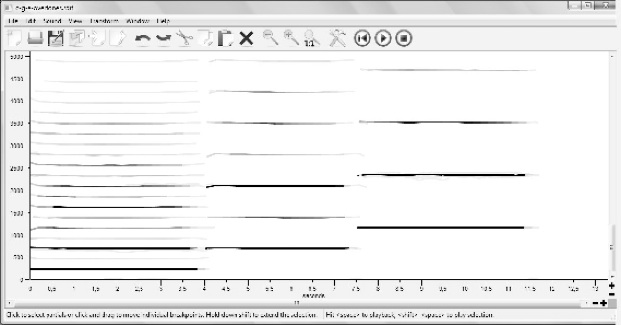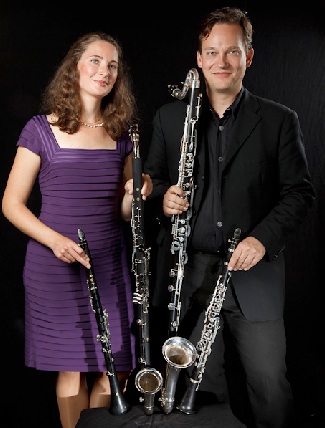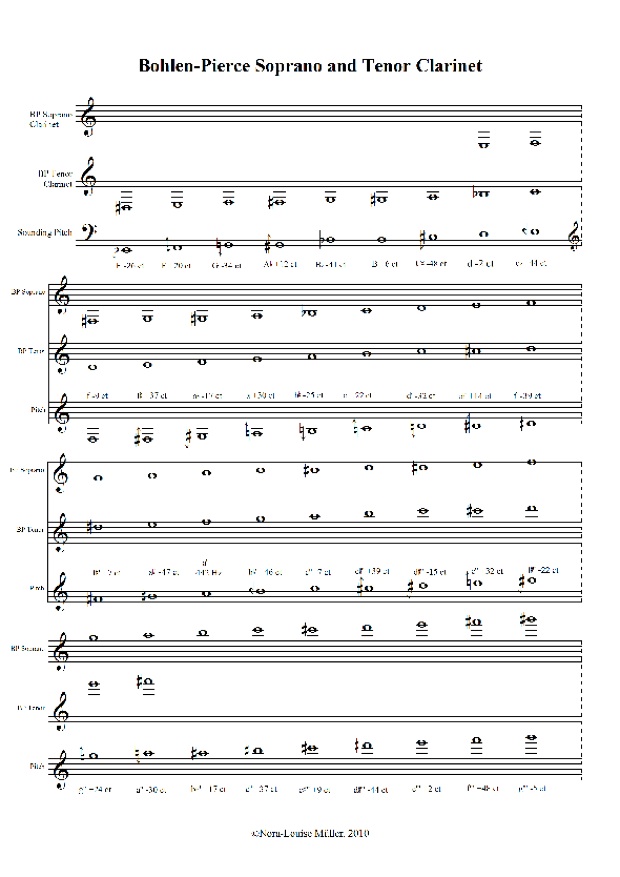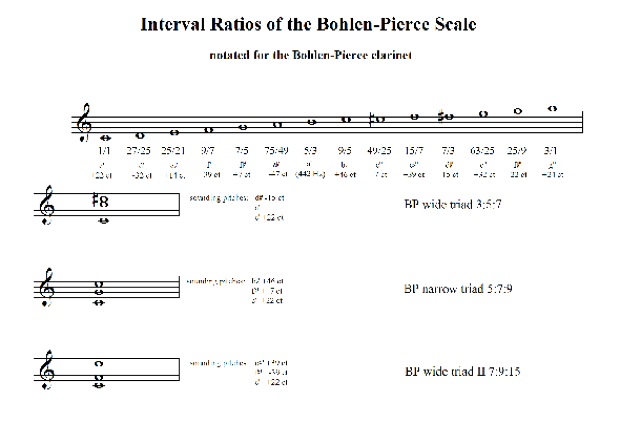The Bohlen-Pierce Clarinet, An Introduction to Acoustics and Playing Technique
The Bohlen-Pierce scale was discovered in the 1970s and 1980s by Heinz Bohlen and John R. Pierce respectively. Due to a lack of instruments which were able to play the scale, hardly any compositions in Bohlen-Pierce could be found in the past. Just a few composers who work in electronic music used the scale – until the Canadian woodwind maker Stephen Fox created a Bohlen-Pierce clarinet, instigated by Georg Hajdu, professor of multimedia composition at Hochschule für Musik und Theater Hamburg. Hence the number of Bohlen-Pierce compositions using the new instrument is increasing constantly. This article gives a short introduction to the characteristics of the Bohlen-Pierce scale and an overview about Bohlen-Pierce clarinets and their playing technique.
The Bohlen-Pierce scaleUnlike the scales of most tone systems, it is not the octave that forms the repeating frame of the Bohlen-Pierce scale, but the perfect twelfth (octave plus fifth), dividing it into 13 steps, according to various mathematical considerations. The result is an alternative harmonic system that opens new possibilities to contemporary and future music.
Acoustically speaking, the octave's frequency ratio 1:2 is replaced by the ratio 1:3 in the Bohlen-Pierce scale, making the perfect twelfth an analogy to the octave. This interval is defined as the point of reference to which the scale aligns. The perfect twelfth, or as Pierce named it, the tritave (due to the 1:3 ratio) is achieved with 13 tone steps. Thus, an alternative harmonic system evolves in which - nota bene - the octave does not appear but is simply stepped over. However, concerning consonance, the ″new″ frame, the tritave, ranks second after the octave due to its similarly simple ratio. The tritave replaces the octave as the frame interval, and, as we will see, interval steps are larger than in the octave-based 12-tone scale. Consequently, chord structures are acoustically different from the ones that can be found in the octave-based 12-tone system.
For example, in the 12-tone system the notes of a major chord have the frequency ratio 4:5:6 (root : third : fifth), and it is acknowledged that its harmonic characteristics are almost perfect. The octave is held as the interval which is most consonant. Stretching the frequency ratios in order to achieve odd numbered ratios gives a chord with a frequency ratio of 3:5:7 (BP wide triad), generating a completely different but apparently harmonic chord. This chord is the ″basic″ Bohlen-Pierce chord from which the scale is derived. It cannot be found in the traditional Western scales. Adding the tritave to the chord, one naturally sees that an inversion of the chord can be made, leading to a chord with the frequency ratios 5:7:9 (BP narrow triad, or BP wide triad 1st inversion). The second inversion has the ratios 7:9:15 (BP wide triad 2nd inversion). Putting these triads as a kind of cluster with the same note as roots and filling the larger gaps between notes where necessary, using the same step size as the smallest intervals we can find between single notes, creates what is called the Bohlen-Pierce chromatic scale with 13 steps. Explained in a slightly simple but easy and quick manner, one can imagine the deviation of the scale like an elastic band: Instead of achieving the octave after twelve semi-tone steps the elastic band is stretched in order to choose the tritave as the returning point. We hence go about one and a half times as far as before, with almost the same number of steps (13). Accordingly, every single step is sized about three-quarters of a tone in the just scale or, in equal temperament, exactly 146.3 cents.
In addition to the Bohlen-Pierce chromatic scale with its 13 steps, various models of diatonic modes in Bohlen-Pierce and their inherent chords have been worked on.
Applying the scale to a clarinet makes the use of the equally tempered version necessary. At least, one is used to wind instruments being tuned equally tempered as a condition to play in any key. In earlier centuries, clarinets were not yet fully equipped with keywork, and a fully chromatic scale could not be played at all or the sound quality of the semitones declined in comparison to the diatonic notes. A clarinetist had to carry a lot of instruments with him, nearly one for every key in which he was supposed to play. By today's standards, a clarinetist brings several instruments, so an equally tempered Bohlen-Pierce model is probably the best regarding the musician's physical health.
Remarkably, the deviations from just intervals are quite small. In a 13ED3 Bohlen-Pierce scale with single step sizes of 146.3 cents, the triads mentioned above deviate only a few cents.
Clarinet acousticsHaving a closer look at clarinet acoustics, it can be seen that the clarinet provides the ideal condition to be adapted to the Bohlen-Pierce scale: Due to its cylindrical bore, the 2nd and 4th harmonics are suppressed in the chalumeau register (fig. 1). The result of the predominant presence of odd harmonics in this register is an overblowing at the twelfth. Listening closely to a clarinet sound in the low (chalumeau) register, one can easily hear the twelfth as the clarinet's first overtone – not the octave as in most acoustic instrument sounds. The octave hardly shows up in the clarinet spectra in the chalumeau register, whilst the twelfth is dominant and clearly audible. The next harmonic which can be heard in the low clarinet sound is the fifth of the harmonic series with the ratio 1:5 since the double-octave (1:4) is suppressed as well. With these two harmonics important notes of the BP triad 3:5:7 are represented.
Spectral analysis of the clarinet sound shows that in the overblown (clarino) register achieved by using the speaker key, the difference in intensity between the odd and even harmonics almost disappears, but the phenomenon of a strong twelfth and a slightly suppressed octave and double-octave can still be seen. Only in the altssimo register, produced by a second overblowing, the octave seems to be equal to the twelfth.

fig. 1: Spectral analysis of sounding b
♭ and its overblowings to f'' and d''' on a b flat clarinet
So far, two different instruments of the Bohlen-Pierce clarinet family have been made: The Bohlen-Pierce soprano and tenor clarinet.
As shown above, the spectra of the clarinet sound differ in the various registers. The characteristics do not change considerably, no matter what kind of clarinet is played. Hence, the same terms for registers can be used for clarinets of any pitch and size, including the Bohlen-Pierce clarinet: The chalumeau register comprises the notated notes e to b
♭'. A twelfth above the bottom e, the overblown or clarino register begins, containing notated b' to c'''. The notes from c#''' upwards are called the altissimo register.

fig. 2: Bohlen-Pierce soprano clarinet by Stephen Fox. Photo: S. Fox
The Bohlen-Pierce soprano and tenor clarinetCompared with the traditional 12-tone scale, the Bohlen-Pierce steps are larger. This means that the mechanic of the Bohlen-Pierce clarinet is considerably simpler than that of a traditional clarinet. It needs less keys to cover the scale's 13 steps up to the tritave. For the lowest notes and the first notes of the clarino register, Fox chooses the same key arrangement as for the Boehm clarinet, i.e. four keys for the right little finger and three keys for the left one (right: keys e/b', f/c', f#/c#' and g#/d#' of the traditional clarinet; left: e/b', f/c' and f#/c#'). The rest of the tritave is produced by six open finger holes, a thumb hole and a key above the first finger hole, operated by the left index finger, equal to the traditional throat a' key. Additionally, Fox put an a' trill key to the instrument, a useful extra feature not only when an a'/b' trill occurs, but apparently essential for every clarinetist who likes to discover the instrument's soft-sounding multiphonics. In the whole, the Bohlen-Pierce soprano clarinet is of the same length as a b
♭ clarinet with a sounding d (notated e) as the bottom note. Compared to a b
♭ clarinet, it has a considerably shorter upper joint and accordingly a longer lower joint. The deviation in length of joints from the traditional clarinet results from the fact that a fingered c' on the Bohlen-Pierce clarinet is a sounding c' +22 cents (ideally) which means that it sounds about one and a quarter tones higher than a b
♭ clarinet when the same fingering is used. Fox decided to separate the clarinet's body into two joints, making the break between the right and left hand fingers, as is usual.
The clarinetist can use the conventional clarinet mouthpiece which he is used to. The author's instrument came with two barrels, one fitting a French mouthpiece and the other one fitting a German mouthpiece. This prototype also had plain finger holes which made playing the clarinet a bit uncomfortable, especially the right ring finger hole which is relatively far away from the middle finger and quite big; a person with slim fingers can find it difficult to cover. Fox solved this problem in later instruments by adding chimneys to raise the open finger holes, giving the player a more comfortable feeling.
A nice advantage of the open finger holes is the fact that glissandi can easily be produced almost throughout the whole range of the instrument, even in registers where it cannot be produced by modulation of embouchure and tongue position. Only the lowest notes which require the use of keys (notated e to g) and the notes directly above the register break plus the break itself (a' to d') are excluded from glissando playing.
Fox's Bohlen-Pierce clarinet is tuned to a'=442 Hz (fingered and notated as b') as a ″matching point″ with the 12-tone scale. As a result, the low d (notated low e) matches aswell. The fingering is the same as on the Boehm clarinet, and instrumentalists and composers came to the wise conclusion that the notation should display the fingerings rather than the sounding pitches which makes the Bohlen-Pierce clarinet a ″transposing″ instrument; to achieve a notation of sounding pitch, every single note has to be ″translated″, one by one, from sounding to notated pitch. There have been trials to use a specific Bohlen-Pierce notation, but relearning the new system adds a disturbing level to playing the instrument and thus reduces the clarinetist's technical mastery and virtuosity.
Playing the Bohlen-Pierce clarinet is a challenge at the beginning. Moving fingers produces totally different pitches and intervals than the clarinetist is used to. This can soon be overcome in the chalumeau and clarino registers after some time of practice, but remains a great difficulty in the altissimo register as the clarinetist's ″inner hearing″ is essential to matching the right note. The higher one plays, the closer the harmonics are to each other, which means that the player has to ″think″ the notes and intervals in tune, otherwise the result will be unpredictable.
Like every wind instrument, the Bohlen-Pierce clarinet requires corrections concerning intonation. Learning Bohlen-Pierce intonation is not as difficult as one would think (except in the altissimo register, see above). Learning the Bohlen-Pierce system and intonation as a duo turned out to be the best way to get familiar with Bohlen-Pierce intonation. By trying it out it can be learned intuitively to a certain extent, except that the players must overcome the temptation to correct the ″octave″, i.e. the 9th scale degree of the Bohlen-Pierce chromatic scale (counting the initial note as no.1) with the frequency ratio 49:25.
The multiphonic repertoire of the Bohlen-Pierce soprano clarinet surprises. Due to the reduced keywork, relatively few of them can be produced compared to a traditional clarinet, and most of them are soft, but very harmonic and ″clean″ in sound. (Research on multiphonics on both the soprano and tenor clarinet will be the subject of later articles.)
Meanwhile, the Bohlen-Pierce soprano clarinet has begun to find its way into contemporary concert life, though at the present there are only five clarinetists worldwide to perform professionally.
Stephen Fox was not satisfied by the development of only one kind of Bohlen-Pierce clarinet. His spirit of research motivated him to create a Bohlen-Pierce clarinet which sounds in a lower register. Expressed in traditional intervals, it sounds a sixth lower than the soprano clarinet. He named his latest creation a Bohlen-Pierce tenor clarinet. The prototype of this instrument was unveiled in March 2010 at the first Bohlen-Pierce symposium in Boston, Massachussetts. It subsequently was purchased by Hochschule für Musik und Theater Hamburg and committed to Àkos Hoffmann and Nora-Louise Müller who were participating as a part of the German delegation. Adding a one-of-a-kind colour by its depth of sound, it is a great enrichment for the work of the Bohlen-Pierce clarinet project in Europe.

fig. 3: Different kinds of clarinets. Left to right: Bohlen-Pierce soprano clarinet, Bohlen-Pierce tenor clarinet; bass clarinet, b flat clarinet.
In concerts, duo Nora-Louise Müller / Ákos Hoffmann uses all of them in various combinations. Photo: C. Ruvolo
The Bohlen-Pierce tenor clarinet is about the size of a traditional alto clarinet, yet larger with a total length of about 133 cm including mouthpiece and a sounding E -26 ct (notated E
♭) as the bottom note. It can be played with common alto clarinet mouthpiece and reeds. The keywork is covered throughout; there are no open sound holes. Thus, glissandi are possible only as far as embouchure and tongue position allow them and cannot be achieved or supported by fingering.
The additional low e
♭ is operated by a fifth key for the right little finger; since from the author's experience, composers appear to like this note very much, a redesign of the right hand little finger key cluster would be reasonable. Fox himself figured out that for future instruments it needs to be brought higher up relative to the hand position than it is in the prototype. One could surely consider replacing the little finger low e
♭ key by a thumb key for the right hand since for many clarinetists it is uncomfortable to stretch the little finger to reach a fifth key. This would also enhance virtuosity in the bottom register by solving one technical problem: as on many Boehm clarinets, the g# / d#'' key only exists for the right little finger and is not doubled for the left hand. Having the low e
♭ only once, as well, causes trouble in playing certain tone sequences within the lowest notes.

fig. 4: Chart displaying the notated (= fingered) and sounding pitches of the Bohlen-Pierce soprano and tenor clarinet

fig. 5: Interval ratios of the single steps of the Bohlen-Pierce chromatic scale in relation to the first scale degree; examples of BP triads in notation for a Bohlen-Pierce clarinet
For better viewing please download pdf-files:
http://www.noralouisemuller.de/BP-soprano-tenor-chart.pdf
http://www.noralouisemuller.de/BPclarinet-interval-ratios.pdf
Composing in the Bohlen-Pierce system requires the composer's willingness to get involved in the particular character of the BP tonality. What strikes us most about Bohlen-Pierce music is the possibility to find completely new soundscapes and aural experiences within a tonal system. Our experience so far is that the "Western ear and brain" which are used to octave-based scales find it intellectually provoking to think of a tonal system which avoids the octave. On the other hand audiences find it inspiring and stimulating to listen to Bohlen-Pierce music as it is often perceived as a kind of "other-wordly music". Bohlen-Pierce music provides new aesthetic horizons for contemporary music. Through its characteristic of being a new and unfamiliar, yet harmonic system, Bohlen-Pierce music has the potential to enrich new music with this special aspect and make contemporary music performances more attractive for a wider public.
The unique harmonies of the Bohlen-Pierce scale are best experienced in performances with several Bohlen-Pierce instruments. For this reason, we are glad to work as a duo, enjoying the possibility of opening our audience's ears to a beautiful tonal world.
1.For more detailed information about the Bohlen-Pierce scale and its deviation, see for example Heinz Bohlen's website http://www.huygens-fokker.org/bpsite/index.html
2.Elaine Walker continues to do thorough research into Bohlen-Pierce modes and scales: http://www.ziaspace.com/elaine/BP/Modes_and_Chords.html
3.equal divisions of 3/1, analogous to EDO (Equal Division of the Octave), as a description for the equally-tempered Bohlen-Pierce scale. One can also describe it as 13-tET3, analogous to 12-tET, adding the 3 after -tET to make clear that it is the tritave which is divided into 13 steps.




